ABC Healthcare: Leadership and Change Management for Patient Education
VerifiedAdded on 2023/01/20
|24
|6605
|41
Essay
AI Summary
This essay critically explores change management within the context of ABC healthcare organization, focusing on the introduction of patient leaflets to improve patient understanding of diseases like diabetes. It examines the impact of political and social changes on organizational structures and the consequences of poor patient understanding. The essay emphasizes the importance of patient self-supervision and the role of patient education leaflets (PILs) in enhancing patient participation and information. It further analyzes the role of clinical leadership in change management, highlighting the skills and strategies required for effective implementation. The discussion covers the roles of first-line managers and the need for effective leadership development to address challenges in healthcare. The essay also discusses the importance of clinical leaders in change management, and how effective implementation of change requires diverse organizational players to serve distinctive roles in the process of change management. The essay uses the SWOT analysis and force field analysis. The ultimate goal is to advocate for successful change and promote best care for patients through effective communication and education. The essay concludes with recommendations for successful change management and the importance of addressing restraining forces.
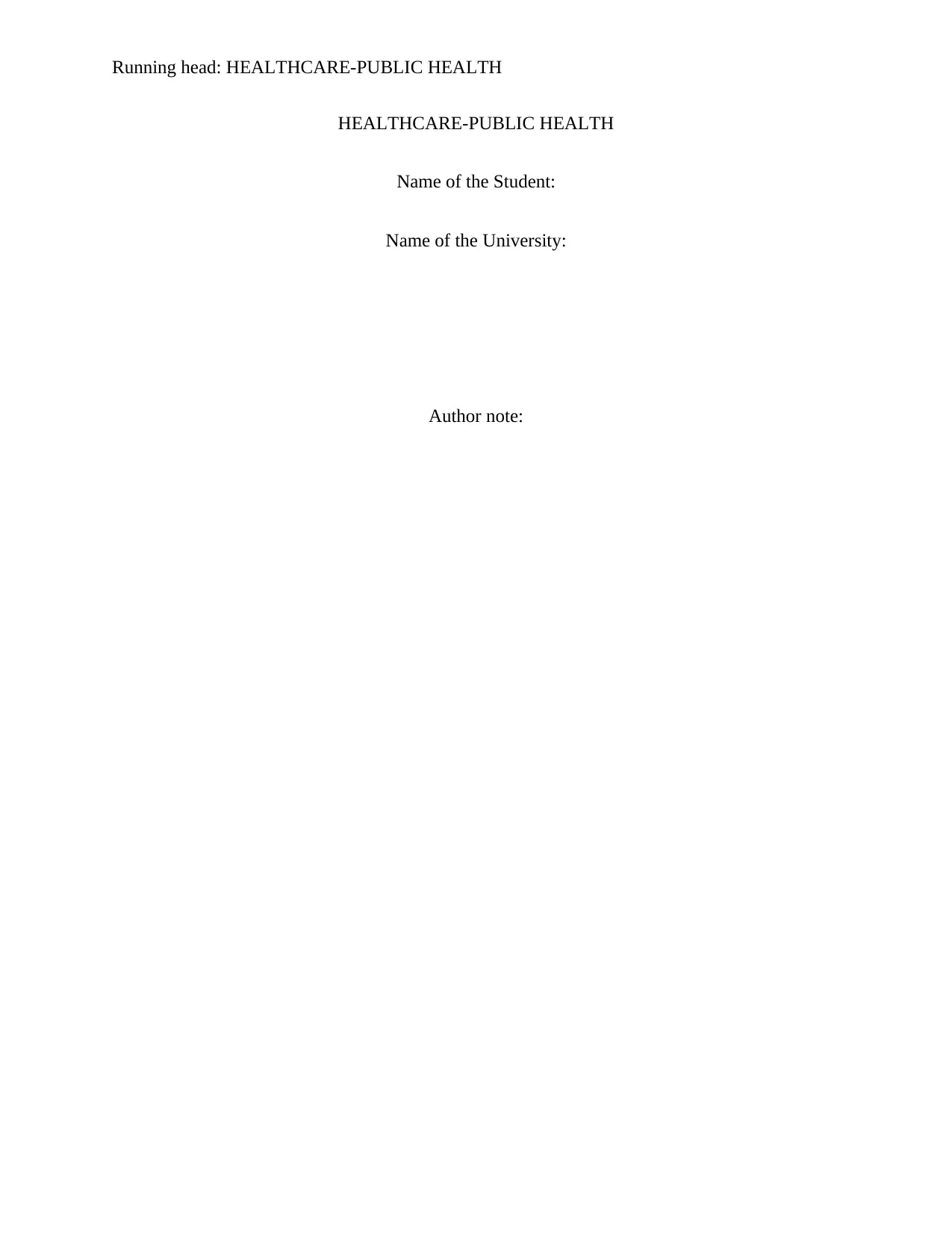
Running head: HEALTHCARE-PUBLIC HEALTH
HEALTHCARE-PUBLIC HEALTH
Name of the Student:
Name of the University:
Author note:
HEALTHCARE-PUBLIC HEALTH
Name of the Student:
Name of the University:
Author note:
Paraphrase This Document
Need a fresh take? Get an instant paraphrase of this document with our AI Paraphraser
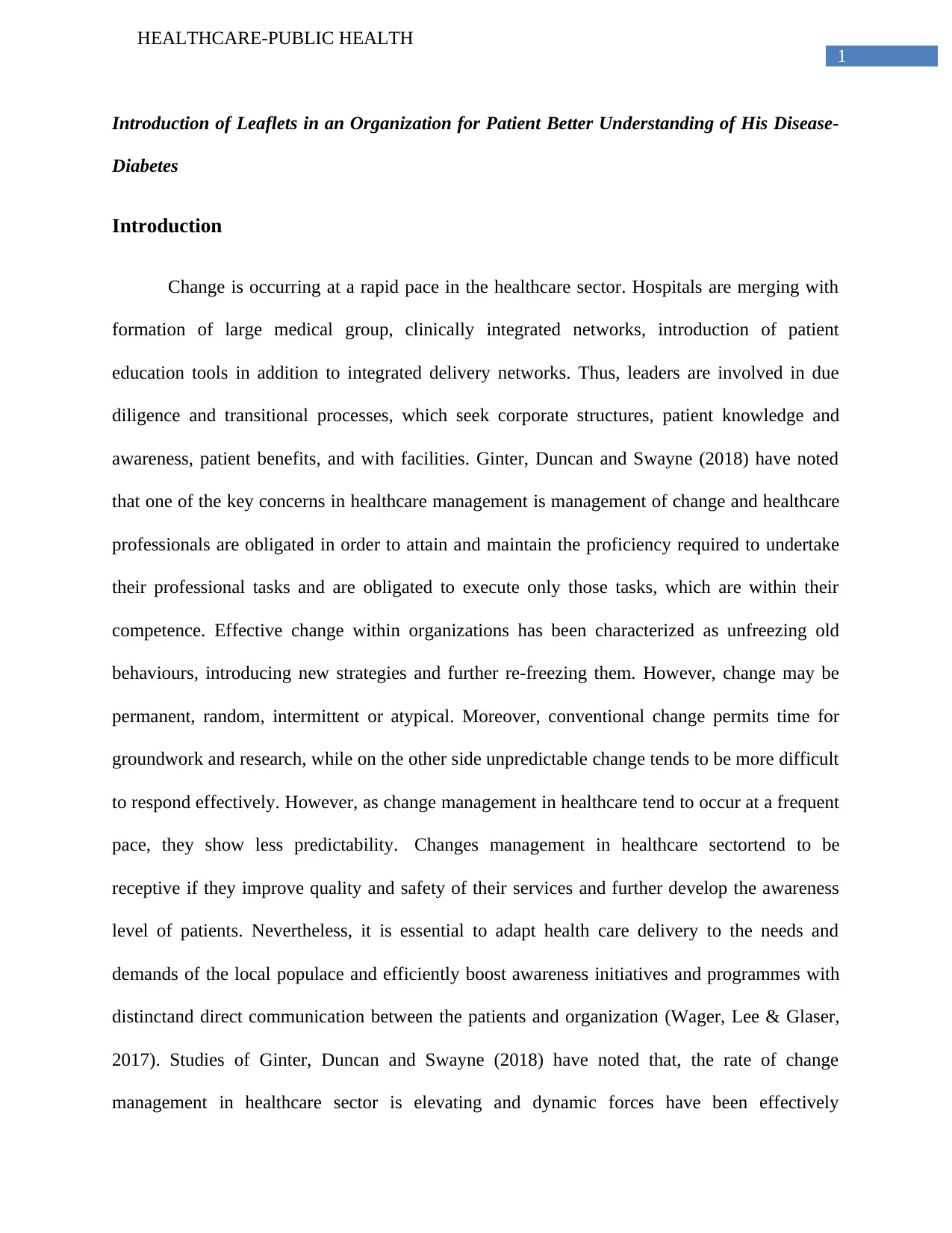
1
HEALTHCARE-PUBLIC HEALTH
Introduction of Leaflets in an Organization for Patient Better Understanding of His Disease-
Diabetes
Introduction
Change is occurring at a rapid pace in the healthcare sector. Hospitals are merging with
formation of large medical group, clinically integrated networks, introduction of patient
education tools in addition to integrated delivery networks. Thus, leaders are involved in due
diligence and transitional processes, which seek corporate structures, patient knowledge and
awareness, patient benefits, and with facilities. Ginter, Duncan and Swayne (2018) have noted
that one of the key concerns in healthcare management is management of change and healthcare
professionals are obligated in order to attain and maintain the proficiency required to undertake
their professional tasks and are obligated to execute only those tasks, which are within their
competence. Effective change within organizations has been characterized as unfreezing old
behaviours, introducing new strategies and further re-freezing them. However, change may be
permanent, random, intermittent or atypical. Moreover, conventional change permits time for
groundwork and research, while on the other side unpredictable change tends to be more difficult
to respond effectively. However, as change management in healthcare tend to occur at a frequent
pace, they show less predictability. Changes management in healthcare sectortend to be
receptive if they improve quality and safety of their services and further develop the awareness
level of patients. Nevertheless, it is essential to adapt health care delivery to the needs and
demands of the local populace and efficiently boost awareness initiatives and programmes with
distinctand direct communication between the patients and organization (Wager, Lee & Glaser,
2017). Studies of Ginter, Duncan and Swayne (2018) have noted that, the rate of change
management in healthcare sector is elevating and dynamic forces have been effectively
HEALTHCARE-PUBLIC HEALTH
Introduction of Leaflets in an Organization for Patient Better Understanding of His Disease-
Diabetes
Introduction
Change is occurring at a rapid pace in the healthcare sector. Hospitals are merging with
formation of large medical group, clinically integrated networks, introduction of patient
education tools in addition to integrated delivery networks. Thus, leaders are involved in due
diligence and transitional processes, which seek corporate structures, patient knowledge and
awareness, patient benefits, and with facilities. Ginter, Duncan and Swayne (2018) have noted
that one of the key concerns in healthcare management is management of change and healthcare
professionals are obligated in order to attain and maintain the proficiency required to undertake
their professional tasks and are obligated to execute only those tasks, which are within their
competence. Effective change within organizations has been characterized as unfreezing old
behaviours, introducing new strategies and further re-freezing them. However, change may be
permanent, random, intermittent or atypical. Moreover, conventional change permits time for
groundwork and research, while on the other side unpredictable change tends to be more difficult
to respond effectively. However, as change management in healthcare tend to occur at a frequent
pace, they show less predictability. Changes management in healthcare sectortend to be
receptive if they improve quality and safety of their services and further develop the awareness
level of patients. Nevertheless, it is essential to adapt health care delivery to the needs and
demands of the local populace and efficiently boost awareness initiatives and programmes with
distinctand direct communication between the patients and organization (Wager, Lee & Glaser,
2017). Studies of Ginter, Duncan and Swayne (2018) have noted that, the rate of change
management in healthcare sector is elevating and dynamic forces have been effectively
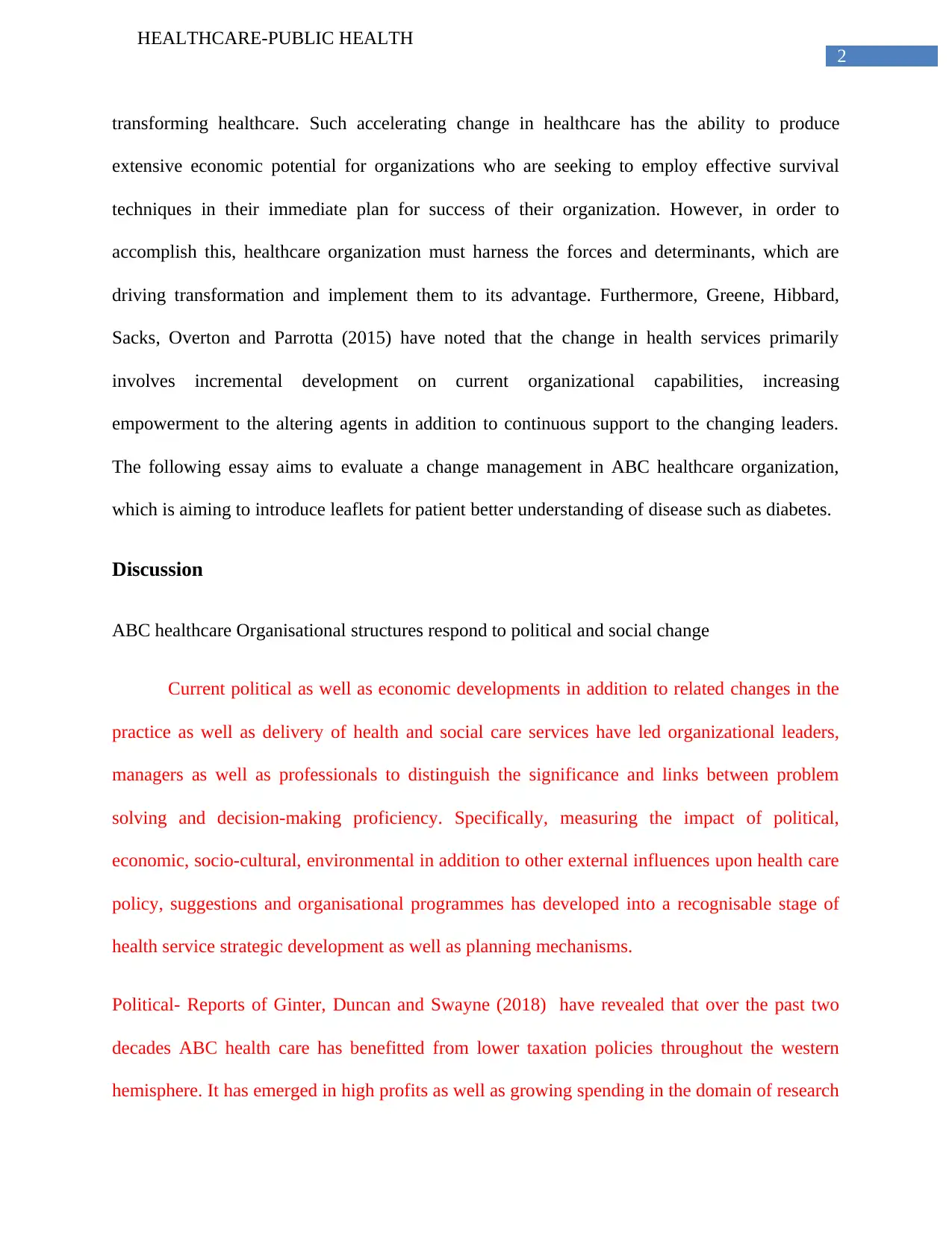
2
HEALTHCARE-PUBLIC HEALTH
transforming healthcare. Such accelerating change in healthcare has the ability to produce
extensive economic potential for organizations who are seeking to employ effective survival
techniques in their immediate plan for success of their organization. However, in order to
accomplish this, healthcare organization must harness the forces and determinants, which are
driving transformation and implement them to its advantage. Furthermore, Greene, Hibbard,
Sacks, Overton and Parrotta (2015) have noted that the change in health services primarily
involves incremental development on current organizational capabilities, increasing
empowerment to the altering agents in addition to continuous support to the changing leaders.
The following essay aims to evaluate a change management in ABC healthcare organization,
which is aiming to introduce leaflets for patient better understanding of disease such as diabetes.
Discussion
ABC healthcare Organisational structures respond to political and social change
Current political as well as economic developments in addition to related changes in the
practice as well as delivery of health and social care services have led organizational leaders,
managers as well as professionals to distinguish the significance and links between problem
solving and decision-making proficiency. Specifically, measuring the impact of political,
economic, socio-cultural, environmental in addition to other external influences upon health care
policy, suggestions and organisational programmes has developed into a recognisable stage of
health service strategic development as well as planning mechanisms.
Political- Reports of Ginter, Duncan and Swayne (2018) have revealed that over the past two
decades ABC health care has benefitted from lower taxation policies throughout the western
hemisphere. It has emerged in high profits as well as growing spending in the domain of research
HEALTHCARE-PUBLIC HEALTH
transforming healthcare. Such accelerating change in healthcare has the ability to produce
extensive economic potential for organizations who are seeking to employ effective survival
techniques in their immediate plan for success of their organization. However, in order to
accomplish this, healthcare organization must harness the forces and determinants, which are
driving transformation and implement them to its advantage. Furthermore, Greene, Hibbard,
Sacks, Overton and Parrotta (2015) have noted that the change in health services primarily
involves incremental development on current organizational capabilities, increasing
empowerment to the altering agents in addition to continuous support to the changing leaders.
The following essay aims to evaluate a change management in ABC healthcare organization,
which is aiming to introduce leaflets for patient better understanding of disease such as diabetes.
Discussion
ABC healthcare Organisational structures respond to political and social change
Current political as well as economic developments in addition to related changes in the
practice as well as delivery of health and social care services have led organizational leaders,
managers as well as professionals to distinguish the significance and links between problem
solving and decision-making proficiency. Specifically, measuring the impact of political,
economic, socio-cultural, environmental in addition to other external influences upon health care
policy, suggestions and organisational programmes has developed into a recognisable stage of
health service strategic development as well as planning mechanisms.
Political- Reports of Ginter, Duncan and Swayne (2018) have revealed that over the past two
decades ABC health care has benefitted from lower taxation policies throughout the western
hemisphere. It has emerged in high profits as well as growing spending in the domain of research
⊘ This is a preview!⊘
Do you want full access?
Subscribe today to unlock all pages.

Trusted by 1+ million students worldwide
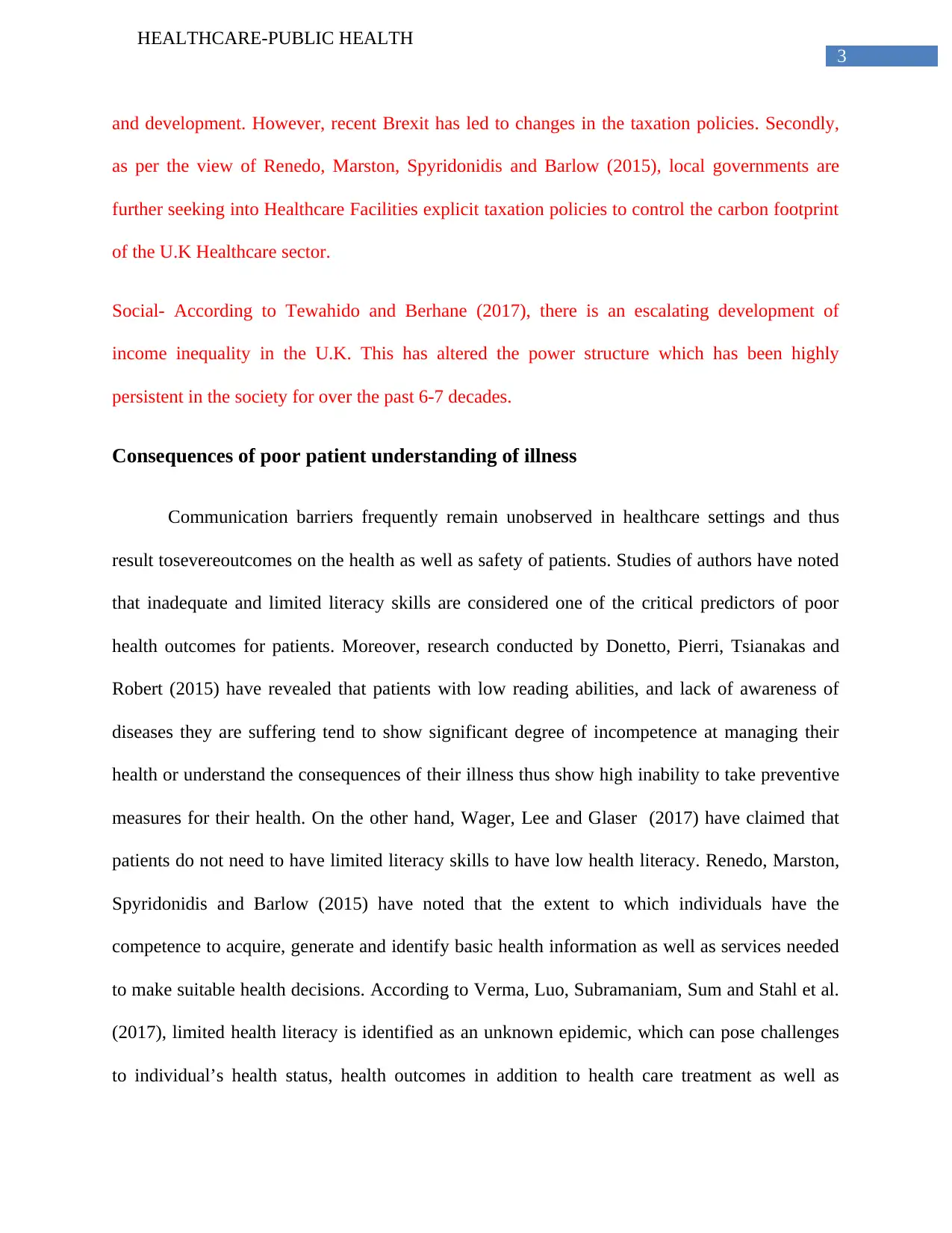
3
HEALTHCARE-PUBLIC HEALTH
and development. However, recent Brexit has led to changes in the taxation policies. Secondly,
as per the view of Renedo, Marston, Spyridonidis and Barlow (2015), local governments are
further seeking into Healthcare Facilities explicit taxation policies to control the carbon footprint
of the U.K Healthcare sector.
Social- According to Tewahido and Berhane (2017), there is an escalating development of
income inequality in the U.K. This has altered the power structure which has been highly
persistent in the society for over the past 6-7 decades.
Consequences of poor patient understanding of illness
Communication barriers frequently remain unobserved in healthcare settings and thus
result tosevereoutcomes on the health as well as safety of patients. Studies of authors have noted
that inadequate and limited literacy skills are considered one of the critical predictors of poor
health outcomes for patients. Moreover, research conducted by Donetto, Pierri, Tsianakas and
Robert (2015) have revealed that patients with low reading abilities, and lack of awareness of
diseases they are suffering tend to show significant degree of incompetence at managing their
health or understand the consequences of their illness thus show high inability to take preventive
measures for their health. On the other hand, Wager, Lee and Glaser (2017) have claimed that
patients do not need to have limited literacy skills to have low health literacy. Renedo, Marston,
Spyridonidis and Barlow (2015) have noted that the extent to which individuals have the
competence to acquire, generate and identify basic health information as well as services needed
to make suitable health decisions. According to Verma, Luo, Subramaniam, Sum and Stahl et al.
(2017), limited health literacy is identified as an unknown epidemic, which can pose challenges
to individual’s health status, health outcomes in addition to health care treatment as well as
HEALTHCARE-PUBLIC HEALTH
and development. However, recent Brexit has led to changes in the taxation policies. Secondly,
as per the view of Renedo, Marston, Spyridonidis and Barlow (2015), local governments are
further seeking into Healthcare Facilities explicit taxation policies to control the carbon footprint
of the U.K Healthcare sector.
Social- According to Tewahido and Berhane (2017), there is an escalating development of
income inequality in the U.K. This has altered the power structure which has been highly
persistent in the society for over the past 6-7 decades.
Consequences of poor patient understanding of illness
Communication barriers frequently remain unobserved in healthcare settings and thus
result tosevereoutcomes on the health as well as safety of patients. Studies of authors have noted
that inadequate and limited literacy skills are considered one of the critical predictors of poor
health outcomes for patients. Moreover, research conducted by Donetto, Pierri, Tsianakas and
Robert (2015) have revealed that patients with low reading abilities, and lack of awareness of
diseases they are suffering tend to show significant degree of incompetence at managing their
health or understand the consequences of their illness thus show high inability to take preventive
measures for their health. On the other hand, Wager, Lee and Glaser (2017) have claimed that
patients do not need to have limited literacy skills to have low health literacy. Renedo, Marston,
Spyridonidis and Barlow (2015) have noted that the extent to which individuals have the
competence to acquire, generate and identify basic health information as well as services needed
to make suitable health decisions. According to Verma, Luo, Subramaniam, Sum and Stahl et al.
(2017), limited health literacy is identified as an unknown epidemic, which can pose challenges
to individual’s health status, health outcomes in addition to health care treatment as well as
Paraphrase This Document
Need a fresh take? Get an instant paraphrase of this document with our AI Paraphraser
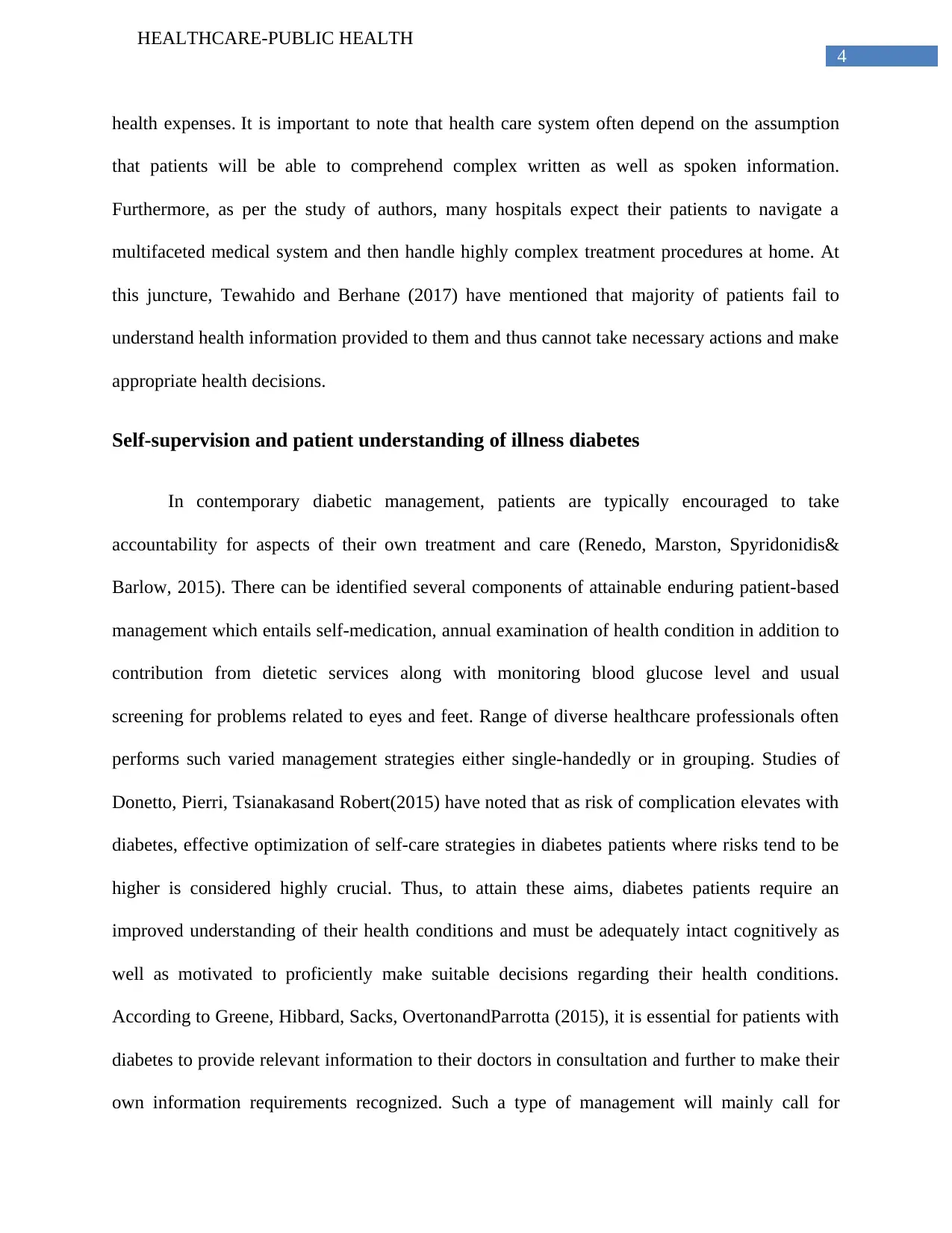
4
HEALTHCARE-PUBLIC HEALTH
health expenses. It is important to note that health care system often depend on the assumption
that patients will be able to comprehend complex written as well as spoken information.
Furthermore, as per the study of authors, many hospitals expect their patients to navigate a
multifaceted medical system and then handle highly complex treatment procedures at home. At
this juncture, Tewahido and Berhane (2017) have mentioned that majority of patients fail to
understand health information provided to them and thus cannot take necessary actions and make
appropriate health decisions.
Self-supervision and patient understanding of illness diabetes
In contemporary diabetic management, patients are typically encouraged to take
accountability for aspects of their own treatment and care (Renedo, Marston, Spyridonidis&
Barlow, 2015). There can be identified several components of attainable enduring patient-based
management which entails self-medication, annual examination of health condition in addition to
contribution from dietetic services along with monitoring blood glucose level and usual
screening for problems related to eyes and feet. Range of diverse healthcare professionals often
performs such varied management strategies either single-handedly or in grouping. Studies of
Donetto, Pierri, Tsianakasand Robert(2015) have noted that as risk of complication elevates with
diabetes, effective optimization of self-care strategies in diabetes patients where risks tend to be
higher is considered highly crucial. Thus, to attain these aims, diabetes patients require an
improved understanding of their health conditions and must be adequately intact cognitively as
well as motivated to proficiently make suitable decisions regarding their health conditions.
According to Greene, Hibbard, Sacks, OvertonandParrotta (2015), it is essential for patients with
diabetes to provide relevant information to their doctors in consultation and further to make their
own information requirements recognized. Such a type of management will mainly call for
HEALTHCARE-PUBLIC HEALTH
health expenses. It is important to note that health care system often depend on the assumption
that patients will be able to comprehend complex written as well as spoken information.
Furthermore, as per the study of authors, many hospitals expect their patients to navigate a
multifaceted medical system and then handle highly complex treatment procedures at home. At
this juncture, Tewahido and Berhane (2017) have mentioned that majority of patients fail to
understand health information provided to them and thus cannot take necessary actions and make
appropriate health decisions.
Self-supervision and patient understanding of illness diabetes
In contemporary diabetic management, patients are typically encouraged to take
accountability for aspects of their own treatment and care (Renedo, Marston, Spyridonidis&
Barlow, 2015). There can be identified several components of attainable enduring patient-based
management which entails self-medication, annual examination of health condition in addition to
contribution from dietetic services along with monitoring blood glucose level and usual
screening for problems related to eyes and feet. Range of diverse healthcare professionals often
performs such varied management strategies either single-handedly or in grouping. Studies of
Donetto, Pierri, Tsianakasand Robert(2015) have noted that as risk of complication elevates with
diabetes, effective optimization of self-care strategies in diabetes patients where risks tend to be
higher is considered highly crucial. Thus, to attain these aims, diabetes patients require an
improved understanding of their health conditions and must be adequately intact cognitively as
well as motivated to proficiently make suitable decisions regarding their health conditions.
According to Greene, Hibbard, Sacks, OvertonandParrotta (2015), it is essential for patients with
diabetes to provide relevant information to their doctors in consultation and further to make their
own information requirements recognized. Such a type of management will mainly call for
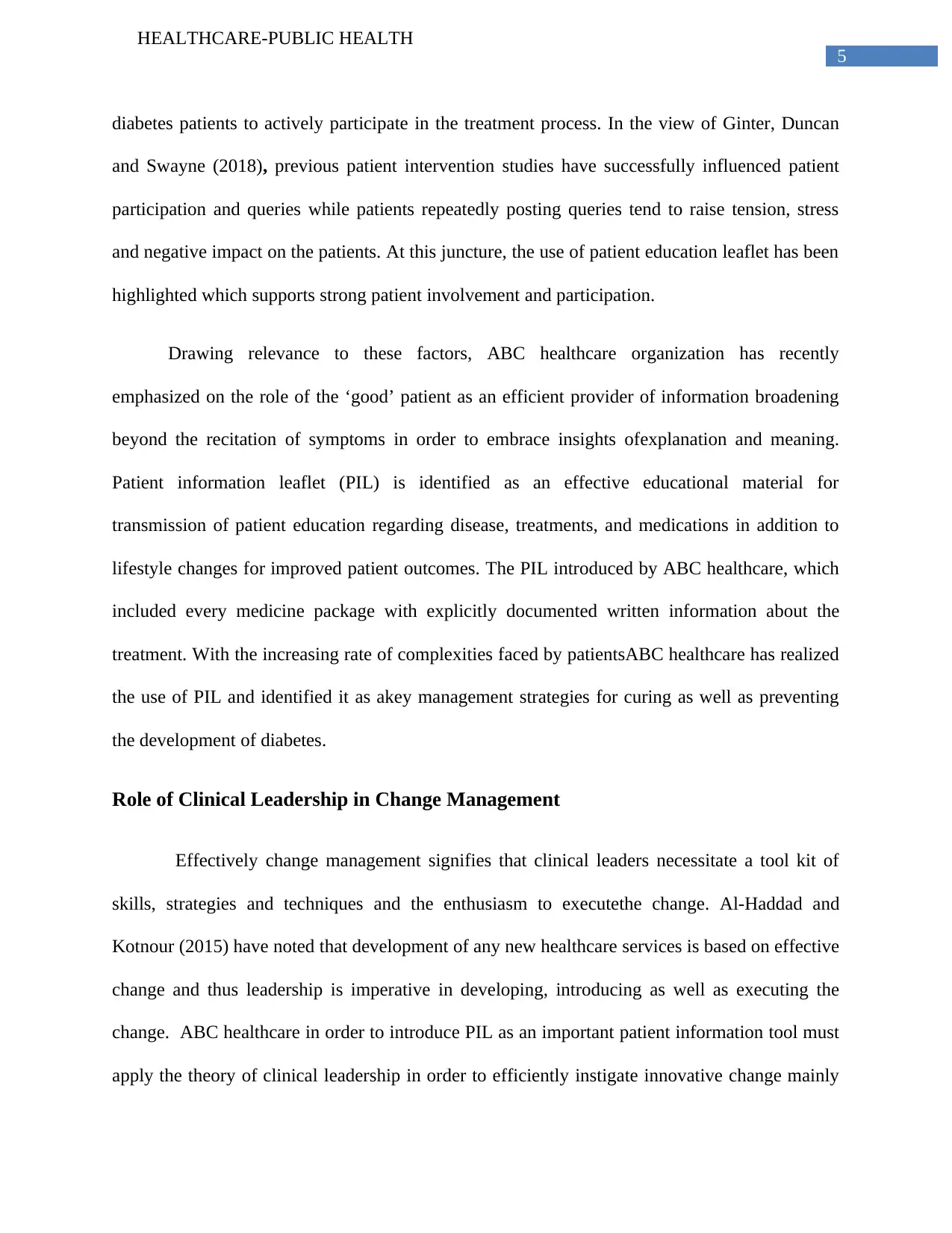
5
HEALTHCARE-PUBLIC HEALTH
diabetes patients to actively participate in the treatment process. In the view of Ginter, Duncan
and Swayne (2018), previous patient intervention studies have successfully influenced patient
participation and queries while patients repeatedly posting queries tend to raise tension, stress
and negative impact on the patients. At this juncture, the use of patient education leaflet has been
highlighted which supports strong patient involvement and participation.
Drawing relevance to these factors, ABC healthcare organization has recently
emphasized on the role of the ‘good’ patient as an efficient provider of information broadening
beyond the recitation of symptoms in order to embrace insights ofexplanation and meaning.
Patient information leaflet (PIL) is identified as an effective educational material for
transmission of patient education regarding disease, treatments, and medications in addition to
lifestyle changes for improved patient outcomes. The PIL introduced by ABC healthcare, which
included every medicine package with explicitly documented written information about the
treatment. With the increasing rate of complexities faced by patientsABC healthcare has realized
the use of PIL and identified it as akey management strategies for curing as well as preventing
the development of diabetes.
Role of Clinical Leadership in Change Management
Effectively change management signifies that clinical leaders necessitate a tool kit of
skills, strategies and techniques and the enthusiasm to executethe change. Al-Haddad and
Kotnour (2015) have noted that development of any new healthcare services is based on effective
change and thus leadership is imperative in developing, introducing as well as executing the
change. ABC healthcare in order to introduce PIL as an important patient information tool must
apply the theory of clinical leadership in order to efficiently instigate innovative change mainly
HEALTHCARE-PUBLIC HEALTH
diabetes patients to actively participate in the treatment process. In the view of Ginter, Duncan
and Swayne (2018), previous patient intervention studies have successfully influenced patient
participation and queries while patients repeatedly posting queries tend to raise tension, stress
and negative impact on the patients. At this juncture, the use of patient education leaflet has been
highlighted which supports strong patient involvement and participation.
Drawing relevance to these factors, ABC healthcare organization has recently
emphasized on the role of the ‘good’ patient as an efficient provider of information broadening
beyond the recitation of symptoms in order to embrace insights ofexplanation and meaning.
Patient information leaflet (PIL) is identified as an effective educational material for
transmission of patient education regarding disease, treatments, and medications in addition to
lifestyle changes for improved patient outcomes. The PIL introduced by ABC healthcare, which
included every medicine package with explicitly documented written information about the
treatment. With the increasing rate of complexities faced by patientsABC healthcare has realized
the use of PIL and identified it as akey management strategies for curing as well as preventing
the development of diabetes.
Role of Clinical Leadership in Change Management
Effectively change management signifies that clinical leaders necessitate a tool kit of
skills, strategies and techniques and the enthusiasm to executethe change. Al-Haddad and
Kotnour (2015) have noted that development of any new healthcare services is based on effective
change and thus leadership is imperative in developing, introducing as well as executing the
change. ABC healthcare in order to introduce PIL as an important patient information tool must
apply the theory of clinical leadership in order to efficiently instigate innovative change mainly
⊘ This is a preview!⊘
Do you want full access?
Subscribe today to unlock all pages.

Trusted by 1+ million students worldwide
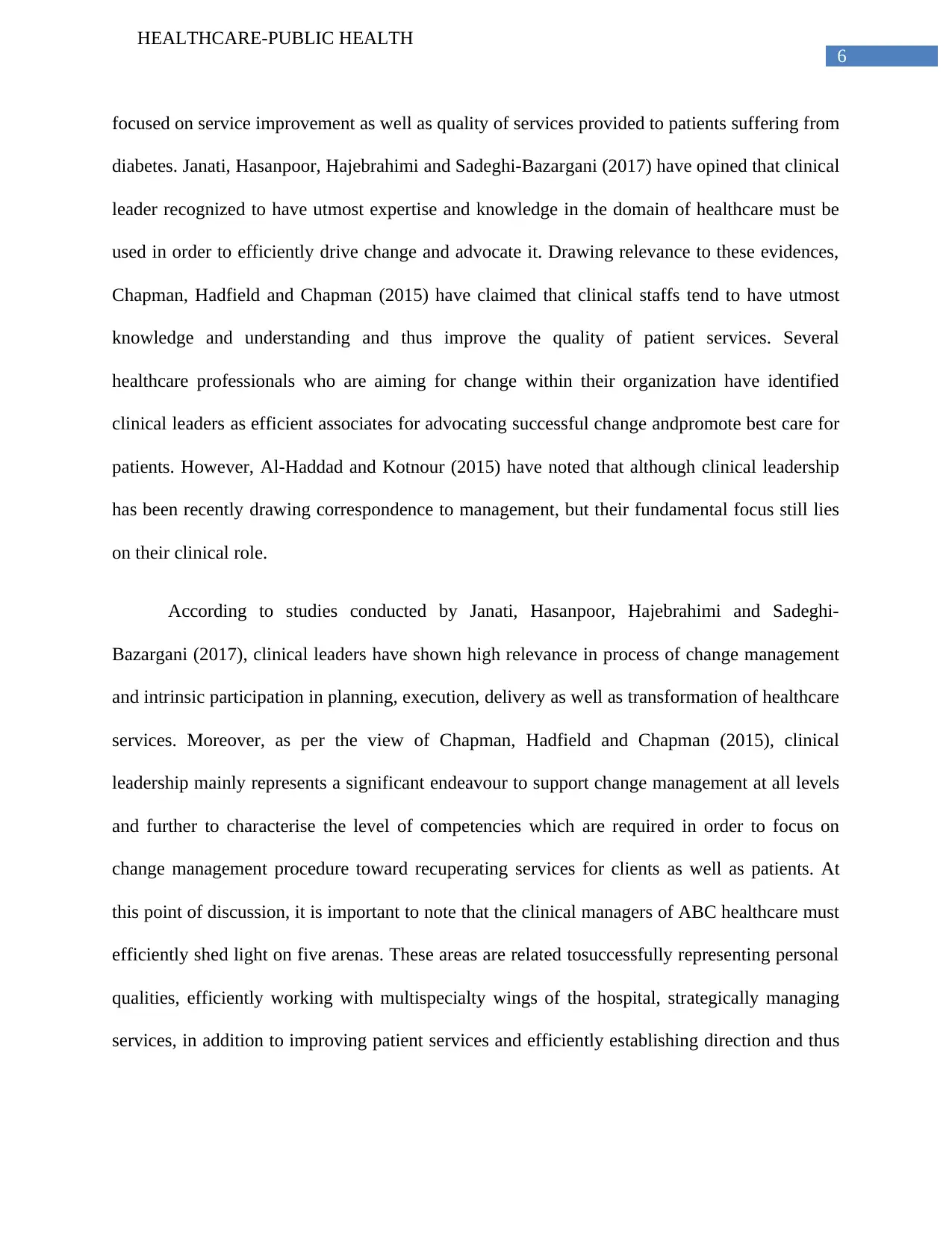
6
HEALTHCARE-PUBLIC HEALTH
focused on service improvement as well as quality of services provided to patients suffering from
diabetes. Janati, Hasanpoor, Hajebrahimi and Sadeghi-Bazargani (2017) have opined that clinical
leader recognized to have utmost expertise and knowledge in the domain of healthcare must be
used in order to efficiently drive change and advocate it. Drawing relevance to these evidences,
Chapman, Hadfield and Chapman (2015) have claimed that clinical staffs tend to have utmost
knowledge and understanding and thus improve the quality of patient services. Several
healthcare professionals who are aiming for change within their organization have identified
clinical leaders as efficient associates for advocating successful change andpromote best care for
patients. However, Al-Haddad and Kotnour (2015) have noted that although clinical leadership
has been recently drawing correspondence to management, but their fundamental focus still lies
on their clinical role.
According to studies conducted by Janati, Hasanpoor, Hajebrahimi and Sadeghi-
Bazargani (2017), clinical leaders have shown high relevance in process of change management
and intrinsic participation in planning, execution, delivery as well as transformation of healthcare
services. Moreover, as per the view of Chapman, Hadfield and Chapman (2015), clinical
leadership mainly represents a significant endeavour to support change management at all levels
and further to characterise the level of competencies which are required in order to focus on
change management procedure toward recuperating services for clients as well as patients. At
this point of discussion, it is important to note that the clinical managers of ABC healthcare must
efficiently shed light on five arenas. These areas are related tosuccessfully representing personal
qualities, efficiently working with multispecialty wings of the hospital, strategically managing
services, in addition to improving patient services and efficiently establishing direction and thus
HEALTHCARE-PUBLIC HEALTH
focused on service improvement as well as quality of services provided to patients suffering from
diabetes. Janati, Hasanpoor, Hajebrahimi and Sadeghi-Bazargani (2017) have opined that clinical
leader recognized to have utmost expertise and knowledge in the domain of healthcare must be
used in order to efficiently drive change and advocate it. Drawing relevance to these evidences,
Chapman, Hadfield and Chapman (2015) have claimed that clinical staffs tend to have utmost
knowledge and understanding and thus improve the quality of patient services. Several
healthcare professionals who are aiming for change within their organization have identified
clinical leaders as efficient associates for advocating successful change andpromote best care for
patients. However, Al-Haddad and Kotnour (2015) have noted that although clinical leadership
has been recently drawing correspondence to management, but their fundamental focus still lies
on their clinical role.
According to studies conducted by Janati, Hasanpoor, Hajebrahimi and Sadeghi-
Bazargani (2017), clinical leaders have shown high relevance in process of change management
and intrinsic participation in planning, execution, delivery as well as transformation of healthcare
services. Moreover, as per the view of Chapman, Hadfield and Chapman (2015), clinical
leadership mainly represents a significant endeavour to support change management at all levels
and further to characterise the level of competencies which are required in order to focus on
change management procedure toward recuperating services for clients as well as patients. At
this point of discussion, it is important to note that the clinical managers of ABC healthcare must
efficiently shed light on five arenas. These areas are related tosuccessfully representing personal
qualities, efficiently working with multispecialty wings of the hospital, strategically managing
services, in addition to improving patient services and efficiently establishing direction and thus
Paraphrase This Document
Need a fresh take? Get an instant paraphrase of this document with our AI Paraphraser
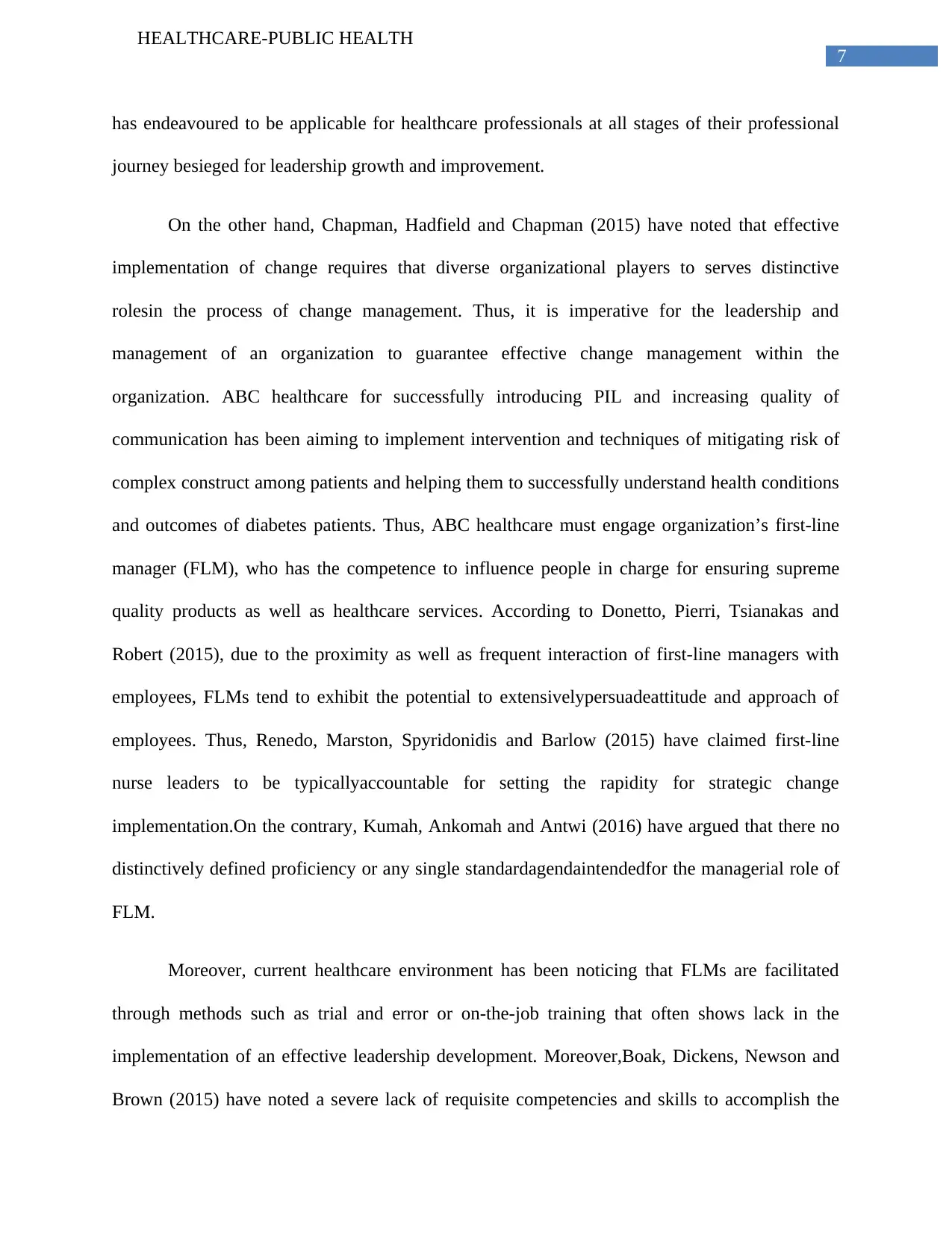
7
HEALTHCARE-PUBLIC HEALTH
has endeavoured to be applicable for healthcare professionals at all stages of their professional
journey besieged for leadership growth and improvement.
On the other hand, Chapman, Hadfield and Chapman (2015) have noted that effective
implementation of change requires that diverse organizational players to serves distinctive
rolesin the process of change management. Thus, it is imperative for the leadership and
management of an organization to guarantee effective change management within the
organization. ABC healthcare for successfully introducing PIL and increasing quality of
communication has been aiming to implement intervention and techniques of mitigating risk of
complex construct among patients and helping them to successfully understand health conditions
and outcomes of diabetes patients. Thus, ABC healthcare must engage organization’s first-line
manager (FLM), who has the competence to influence people in charge for ensuring supreme
quality products as well as healthcare services. According to Donetto, Pierri, Tsianakas and
Robert (2015), due to the proximity as well as frequent interaction of first-line managers with
employees, FLMs tend to exhibit the potential to extensivelypersuadeattitude and approach of
employees. Thus, Renedo, Marston, Spyridonidis and Barlow (2015) have claimed first-line
nurse leaders to be typicallyaccountable for setting the rapidity for strategic change
implementation.On the contrary, Kumah, Ankomah and Antwi (2016) have argued that there no
distinctively defined proficiency or any single standardagendaintendedfor the managerial role of
FLM.
Moreover, current healthcare environment has been noticing that FLMs are facilitated
through methods such as trial and error or on-the-job training that often shows lack in the
implementation of an effective leadership development. Moreover,Boak, Dickens, Newson and
Brown (2015) have noted a severe lack of requisite competencies and skills to accomplish the
HEALTHCARE-PUBLIC HEALTH
has endeavoured to be applicable for healthcare professionals at all stages of their professional
journey besieged for leadership growth and improvement.
On the other hand, Chapman, Hadfield and Chapman (2015) have noted that effective
implementation of change requires that diverse organizational players to serves distinctive
rolesin the process of change management. Thus, it is imperative for the leadership and
management of an organization to guarantee effective change management within the
organization. ABC healthcare for successfully introducing PIL and increasing quality of
communication has been aiming to implement intervention and techniques of mitigating risk of
complex construct among patients and helping them to successfully understand health conditions
and outcomes of diabetes patients. Thus, ABC healthcare must engage organization’s first-line
manager (FLM), who has the competence to influence people in charge for ensuring supreme
quality products as well as healthcare services. According to Donetto, Pierri, Tsianakas and
Robert (2015), due to the proximity as well as frequent interaction of first-line managers with
employees, FLMs tend to exhibit the potential to extensivelypersuadeattitude and approach of
employees. Thus, Renedo, Marston, Spyridonidis and Barlow (2015) have claimed first-line
nurse leaders to be typicallyaccountable for setting the rapidity for strategic change
implementation.On the contrary, Kumah, Ankomah and Antwi (2016) have argued that there no
distinctively defined proficiency or any single standardagendaintendedfor the managerial role of
FLM.
Moreover, current healthcare environment has been noticing that FLMs are facilitated
through methods such as trial and error or on-the-job training that often shows lack in the
implementation of an effective leadership development. Moreover,Boak, Dickens, Newson and
Brown (2015) have noted a severe lack of requisite competencies and skills to accomplish the
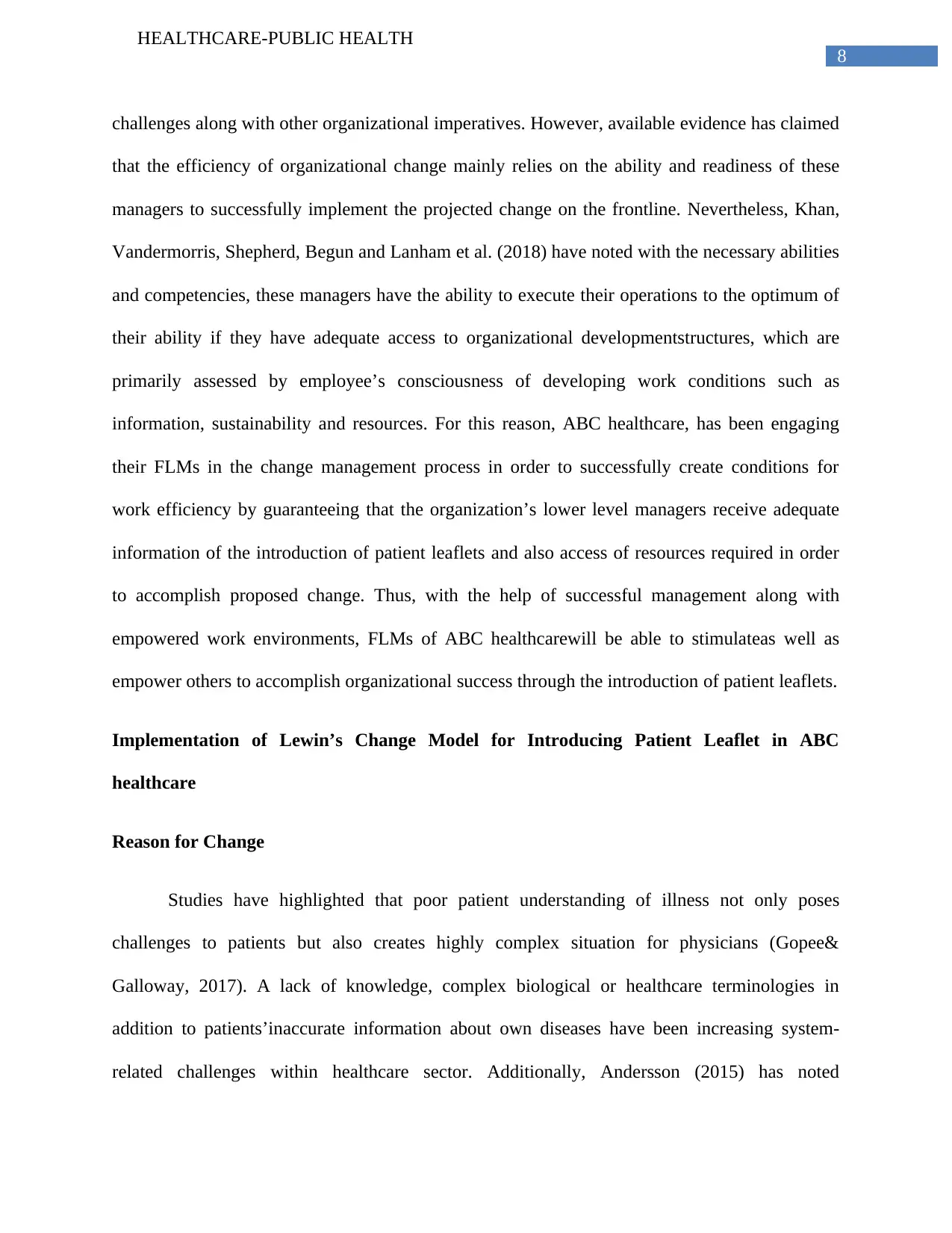
8
HEALTHCARE-PUBLIC HEALTH
challenges along with other organizational imperatives. However, available evidence has claimed
that the efficiency of organizational change mainly relies on the ability and readiness of these
managers to successfully implement the projected change on the frontline. Nevertheless, Khan,
Vandermorris, Shepherd, Begun and Lanham et al. (2018) have noted with the necessary abilities
and competencies, these managers have the ability to execute their operations to the optimum of
their ability if they have adequate access to organizational developmentstructures, which are
primarily assessed by employee’s consciousness of developing work conditions such as
information, sustainability and resources. For this reason, ABC healthcare, has been engaging
their FLMs in the change management process in order to successfully create conditions for
work efficiency by guaranteeing that the organization’s lower level managers receive adequate
information of the introduction of patient leaflets and also access of resources required in order
to accomplish proposed change. Thus, with the help of successful management along with
empowered work environments, FLMs of ABC healthcarewill be able to stimulateas well as
empower others to accomplish organizational success through the introduction of patient leaflets.
Implementation of Lewin’s Change Model for Introducing Patient Leaflet in ABC
healthcare
Reason for Change
Studies have highlighted that poor patient understanding of illness not only poses
challenges to patients but also creates highly complex situation for physicians (Gopee&
Galloway, 2017). A lack of knowledge, complex biological or healthcare terminologies in
addition to patients’inaccurate information about own diseases have been increasing system-
related challenges within healthcare sector. Additionally, Andersson (2015) has noted
HEALTHCARE-PUBLIC HEALTH
challenges along with other organizational imperatives. However, available evidence has claimed
that the efficiency of organizational change mainly relies on the ability and readiness of these
managers to successfully implement the projected change on the frontline. Nevertheless, Khan,
Vandermorris, Shepherd, Begun and Lanham et al. (2018) have noted with the necessary abilities
and competencies, these managers have the ability to execute their operations to the optimum of
their ability if they have adequate access to organizational developmentstructures, which are
primarily assessed by employee’s consciousness of developing work conditions such as
information, sustainability and resources. For this reason, ABC healthcare, has been engaging
their FLMs in the change management process in order to successfully create conditions for
work efficiency by guaranteeing that the organization’s lower level managers receive adequate
information of the introduction of patient leaflets and also access of resources required in order
to accomplish proposed change. Thus, with the help of successful management along with
empowered work environments, FLMs of ABC healthcarewill be able to stimulateas well as
empower others to accomplish organizational success through the introduction of patient leaflets.
Implementation of Lewin’s Change Model for Introducing Patient Leaflet in ABC
healthcare
Reason for Change
Studies have highlighted that poor patient understanding of illness not only poses
challenges to patients but also creates highly complex situation for physicians (Gopee&
Galloway, 2017). A lack of knowledge, complex biological or healthcare terminologies in
addition to patients’inaccurate information about own diseases have been increasing system-
related challenges within healthcare sector. Additionally, Andersson (2015) has noted
⊘ This is a preview!⊘
Do you want full access?
Subscribe today to unlock all pages.

Trusted by 1+ million students worldwide
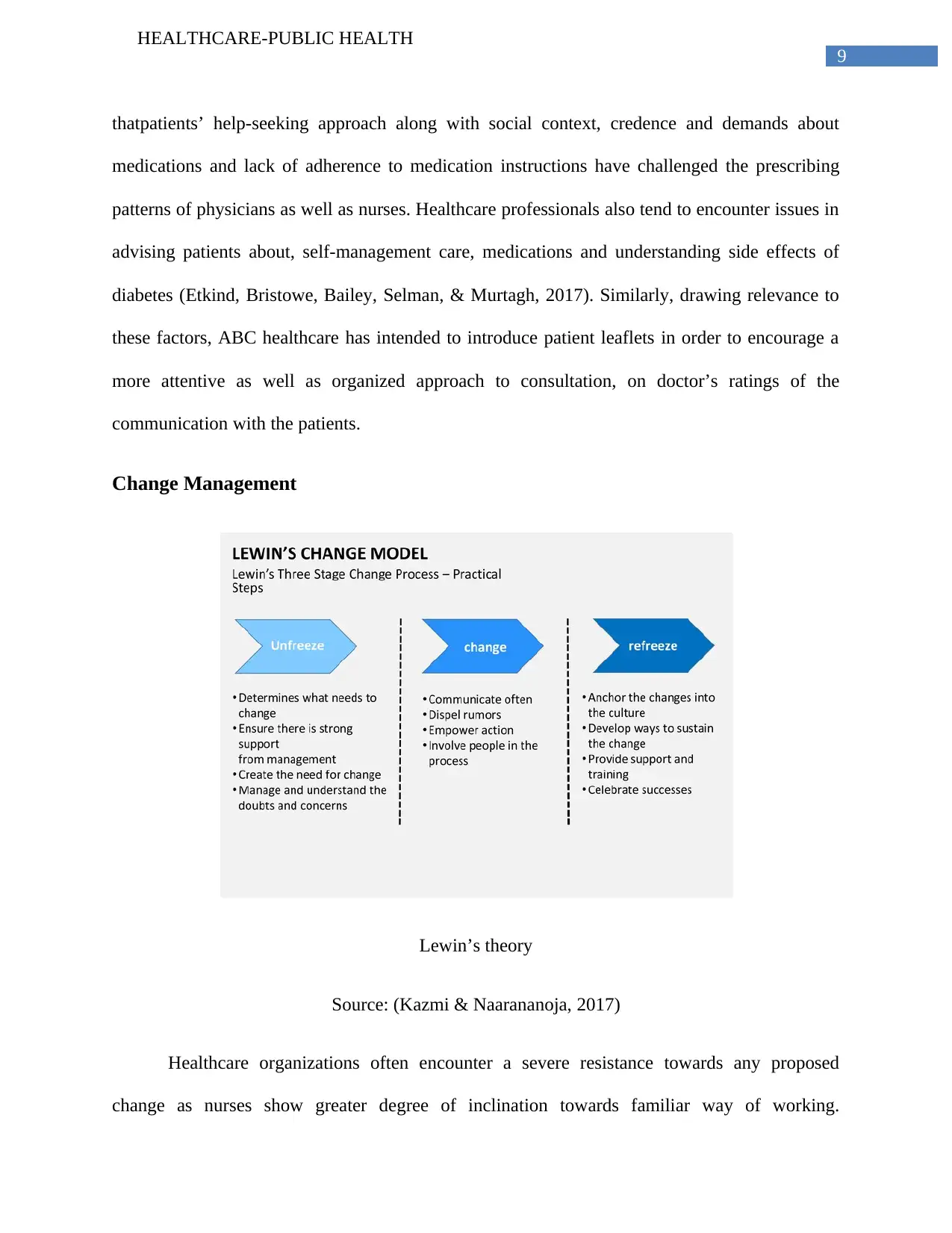
9
HEALTHCARE-PUBLIC HEALTH
thatpatients’ help-seeking approach along with social context, credence and demands about
medications and lack of adherence to medication instructions have challenged the prescribing
patterns of physicians as well as nurses. Healthcare professionals also tend to encounter issues in
advising patients about, self-management care, medications and understanding side effects of
diabetes (Etkind, Bristowe, Bailey, Selman, & Murtagh, 2017). Similarly, drawing relevance to
these factors, ABC healthcare has intended to introduce patient leaflets in order to encourage a
more attentive as well as organized approach to consultation, on doctor’s ratings of the
communication with the patients.
Change Management
Lewin’s theory
Source: (Kazmi & Naarananoja, 2017)
Healthcare organizations often encounter a severe resistance towards any proposed
change as nurses show greater degree of inclination towards familiar way of working.
HEALTHCARE-PUBLIC HEALTH
thatpatients’ help-seeking approach along with social context, credence and demands about
medications and lack of adherence to medication instructions have challenged the prescribing
patterns of physicians as well as nurses. Healthcare professionals also tend to encounter issues in
advising patients about, self-management care, medications and understanding side effects of
diabetes (Etkind, Bristowe, Bailey, Selman, & Murtagh, 2017). Similarly, drawing relevance to
these factors, ABC healthcare has intended to introduce patient leaflets in order to encourage a
more attentive as well as organized approach to consultation, on doctor’s ratings of the
communication with the patients.
Change Management
Lewin’s theory
Source: (Kazmi & Naarananoja, 2017)
Healthcare organizations often encounter a severe resistance towards any proposed
change as nurses show greater degree of inclination towards familiar way of working.
Paraphrase This Document
Need a fresh take? Get an instant paraphrase of this document with our AI Paraphraser
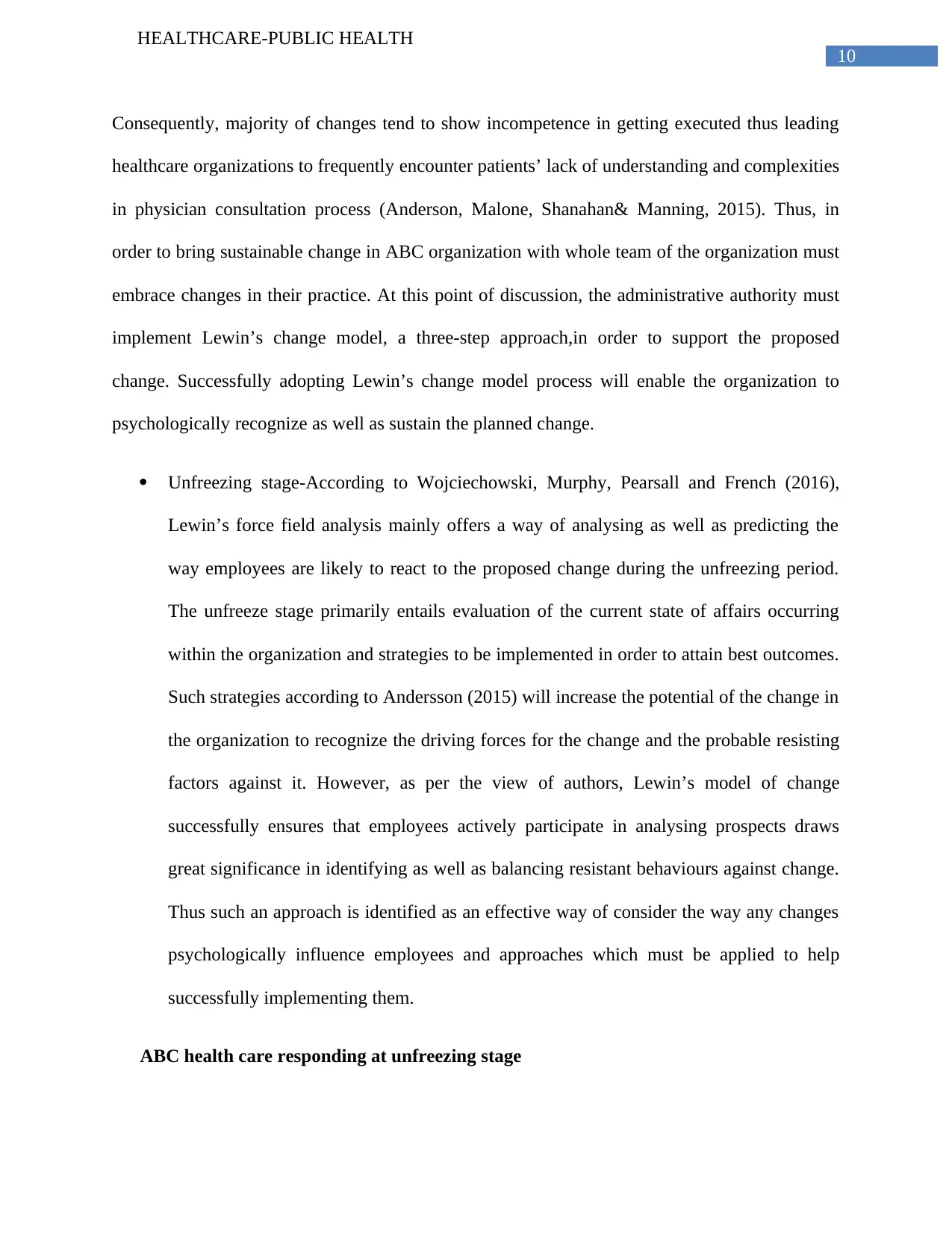
10
HEALTHCARE-PUBLIC HEALTH
Consequently, majority of changes tend to show incompetence in getting executed thus leading
healthcare organizations to frequently encounter patients’ lack of understanding and complexities
in physician consultation process (Anderson, Malone, Shanahan& Manning, 2015). Thus, in
order to bring sustainable change in ABC organization with whole team of the organization must
embrace changes in their practice. At this point of discussion, the administrative authority must
implement Lewin’s change model, a three-step approach,in order to support the proposed
change. Successfully adopting Lewin’s change model process will enable the organization to
psychologically recognize as well as sustain the planned change.
Unfreezing stage-According to Wojciechowski, Murphy, Pearsall and French (2016),
Lewin’s force field analysis mainly offers a way of analysing as well as predicting the
way employees are likely to react to the proposed change during the unfreezing period.
The unfreeze stage primarily entails evaluation of the current state of affairs occurring
within the organization and strategies to be implemented in order to attain best outcomes.
Such strategies according to Andersson (2015) will increase the potential of the change in
the organization to recognize the driving forces for the change and the probable resisting
factors against it. However, as per the view of authors, Lewin’s model of change
successfully ensures that employees actively participate in analysing prospects draws
great significance in identifying as well as balancing resistant behaviours against change.
Thus such an approach is identified as an effective way of consider the way any changes
psychologically influence employees and approaches which must be applied to help
successfully implementing them.
ABC health care responding at unfreezing stage
HEALTHCARE-PUBLIC HEALTH
Consequently, majority of changes tend to show incompetence in getting executed thus leading
healthcare organizations to frequently encounter patients’ lack of understanding and complexities
in physician consultation process (Anderson, Malone, Shanahan& Manning, 2015). Thus, in
order to bring sustainable change in ABC organization with whole team of the organization must
embrace changes in their practice. At this point of discussion, the administrative authority must
implement Lewin’s change model, a three-step approach,in order to support the proposed
change. Successfully adopting Lewin’s change model process will enable the organization to
psychologically recognize as well as sustain the planned change.
Unfreezing stage-According to Wojciechowski, Murphy, Pearsall and French (2016),
Lewin’s force field analysis mainly offers a way of analysing as well as predicting the
way employees are likely to react to the proposed change during the unfreezing period.
The unfreeze stage primarily entails evaluation of the current state of affairs occurring
within the organization and strategies to be implemented in order to attain best outcomes.
Such strategies according to Andersson (2015) will increase the potential of the change in
the organization to recognize the driving forces for the change and the probable resisting
factors against it. However, as per the view of authors, Lewin’s model of change
successfully ensures that employees actively participate in analysing prospects draws
great significance in identifying as well as balancing resistant behaviours against change.
Thus such an approach is identified as an effective way of consider the way any changes
psychologically influence employees and approaches which must be applied to help
successfully implementing them.
ABC health care responding at unfreezing stage
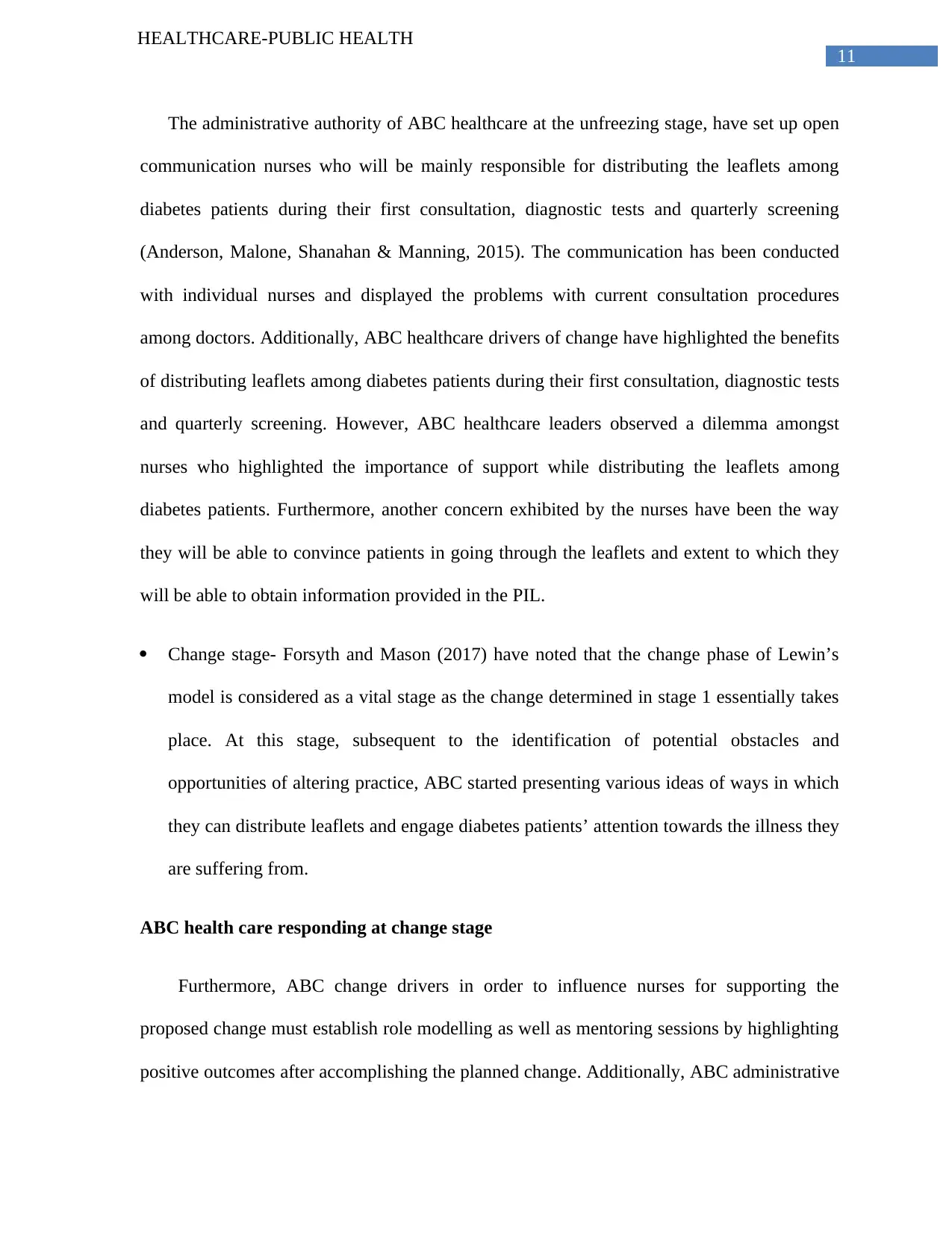
11
HEALTHCARE-PUBLIC HEALTH
The administrative authority of ABC healthcare at the unfreezing stage, have set up open
communication nurses who will be mainly responsible for distributing the leaflets among
diabetes patients during their first consultation, diagnostic tests and quarterly screening
(Anderson, Malone, Shanahan & Manning, 2015). The communication has been conducted
with individual nurses and displayed the problems with current consultation procedures
among doctors. Additionally, ABC healthcare drivers of change have highlighted the benefits
of distributing leaflets among diabetes patients during their first consultation, diagnostic tests
and quarterly screening. However, ABC healthcare leaders observed a dilemma amongst
nurses who highlighted the importance of support while distributing the leaflets among
diabetes patients. Furthermore, another concern exhibited by the nurses have been the way
they will be able to convince patients in going through the leaflets and extent to which they
will be able to obtain information provided in the PIL.
Change stage- Forsyth and Mason (2017) have noted that the change phase of Lewin’s
model is considered as a vital stage as the change determined in stage 1 essentially takes
place. At this stage, subsequent to the identification of potential obstacles and
opportunities of altering practice, ABC started presenting various ideas of ways in which
they can distribute leaflets and engage diabetes patients’ attention towards the illness they
are suffering from.
ABC health care responding at change stage
Furthermore, ABC change drivers in order to influence nurses for supporting the
proposed change must establish role modelling as well as mentoring sessions by highlighting
positive outcomes after accomplishing the planned change. Additionally, ABC administrative
HEALTHCARE-PUBLIC HEALTH
The administrative authority of ABC healthcare at the unfreezing stage, have set up open
communication nurses who will be mainly responsible for distributing the leaflets among
diabetes patients during their first consultation, diagnostic tests and quarterly screening
(Anderson, Malone, Shanahan & Manning, 2015). The communication has been conducted
with individual nurses and displayed the problems with current consultation procedures
among doctors. Additionally, ABC healthcare drivers of change have highlighted the benefits
of distributing leaflets among diabetes patients during their first consultation, diagnostic tests
and quarterly screening. However, ABC healthcare leaders observed a dilemma amongst
nurses who highlighted the importance of support while distributing the leaflets among
diabetes patients. Furthermore, another concern exhibited by the nurses have been the way
they will be able to convince patients in going through the leaflets and extent to which they
will be able to obtain information provided in the PIL.
Change stage- Forsyth and Mason (2017) have noted that the change phase of Lewin’s
model is considered as a vital stage as the change determined in stage 1 essentially takes
place. At this stage, subsequent to the identification of potential obstacles and
opportunities of altering practice, ABC started presenting various ideas of ways in which
they can distribute leaflets and engage diabetes patients’ attention towards the illness they
are suffering from.
ABC health care responding at change stage
Furthermore, ABC change drivers in order to influence nurses for supporting the
proposed change must establish role modelling as well as mentoring sessions by highlighting
positive outcomes after accomplishing the planned change. Additionally, ABC administrative
⊘ This is a preview!⊘
Do you want full access?
Subscribe today to unlock all pages.

Trusted by 1+ million students worldwide
1 out of 24
Related Documents
Your All-in-One AI-Powered Toolkit for Academic Success.
+13062052269
info@desklib.com
Available 24*7 on WhatsApp / Email
![[object Object]](/_next/static/media/star-bottom.7253800d.svg)
Unlock your academic potential
Copyright © 2020–2025 A2Z Services. All Rights Reserved. Developed and managed by ZUCOL.





